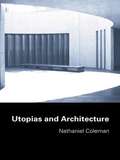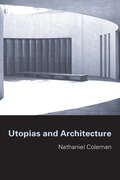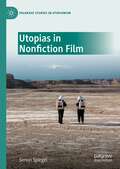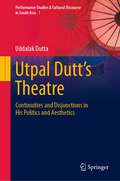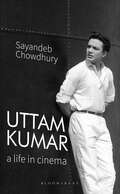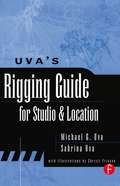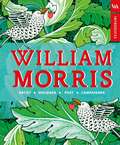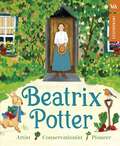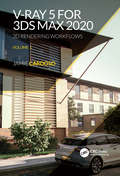- Table View
- List View
The Utopian Fantastic: Selected Essays from the Twentieth International Conference on the Fantastic in the Arts (Contributions to the Study of Science Fiction and Fantasy)
by Martha A. BartterUtopia forms a major aspect of human desire, one that is as important as religion. Understanding utopia and the ways in which it can collapse into dystopia is crucial in many disciplines. Fantastic literature (including science fiction and fantasy) is the only form of literature that takes utopia/dystopia seriously. Therefore, analysis of these works provides a basis for serious experimentation in social science.In this volume, critics analyze contemporary literary thought experiments such as 1984 and We. They show how utopian experiments can easily slide into dystopia. Exploring these fictional sociocultural, political experiments gives us new ways to think about our lives and culture. While literature, history, and political science professors may find this book useful, it can also serve as a call to arms to anyone dedicated to maintaining freedom and humane living in the world today.
The Utopian Globalists: Artists of Worldwide Revolution, 1919 - 2009
by Jonathan HarrisAn innovative history and critical account mapping the ways artists and their works have engaged with, and offered commentary on, modern spectacle in both capitalist and socialist modernism over the past ninety years. Focuses on artists whose work expresses the concept of revolutionary social transformation Provides a strong historical narrative that adds structure and clarity Features a cogent and innovative critique of contemporary art and institutions Covers 100 years of art from Vladimir Tatlin’s constructivist ‘Monument to the Third International’, to Picasso’s late 1940s commitment to Communism, to the Unilever Series sponsored Large Artworks installed at London’s Tate Modern since 2000. Includes the only substantial account in print of John Lennon and Yoko Ono’s 1969 Montreal ‘Bed-in’ Offers an accessible description and interpretation of Debord’s ‘society of the spectacle’ theory
The Utopian Globalists: Artists of Worldwide Revolution, 1919 - 2009
by Jonathan HarrisAn innovative history and critical account mapping the ways artists and their works have engaged with, and offered commentary on, modern spectacle in both capitalist and socialist modernism over the past ninety years. Focuses on artists whose work expresses the concept of revolutionary social transformation Provides a strong historical narrative that adds structure and clarity Features a cogent and innovative critique of contemporary art and institutions Covers 100 years of art from Vladimir Tatlin’s constructivist ‘Monument to the Third International’, to Picasso’s late 1940s commitment to Communism, to the Unilever Series sponsored Large Artworks installed at London’s Tate Modern since 2000. Includes the only substantial account in print of John Lennon and Yoko Ono’s 1969 Montreal ‘Bed-in’ Offers an accessible description and interpretation of Debord’s ‘society of the spectacle’ theory
Utopian Pulse: Flares in the Darkroom
by Ines Doujak Oliver ResslerThe politics of Utopia have already produced a rich and varied literature - St. Simon, Buber, Bloch, and many others. Utopian Pulse explores this tradition from the perspective of art practice and asks how we can engage with and contribute to it. This book will be published alongside an exhibition of the same name and will include artwork from the exhibition itself. *BR**BR*The work's contributors invoke Utopia as an always incomplete alternative and a recognition of something missing, which opens up the possibility of asserting something which is not yet but will be. International artistic researchers, artists and artist-curators contribute different modes of engagement which they are already constituting through their own practice. More than just a theoretical treatise, this book is an overview of a series of works and projects that are brought to life and which the book seeks to document.*BR**BR*This book will serve not only as a contribution to the existing literature on Utopia and Utopian politics, but also as an inspiration to artists seeking to realise these ideas through their work.
Utopias and Architecture
by Nathaniel ColemanUtopian thought, though commonly characterized as projecting a future without a past, depends on golden models for re-invention of what is. Through a detailed and innovative re-assessment of the work of three architects who sought to represent a utopian content in their work, and a consideration of the thoughts of a range of leading writers, Coleman offers the reader a unique perspective of idealism in architectural design. With unparalleled depth and focus of vision on the work of Le Corbusier, Louis I Kahn and Aldo van Eyck, this book persuasively challenges predominant assumptions in current architectural discourse, forging a new approach to the invention of welcoming built environments and transcending the limitations of both the postmodern and hyper-modern stance and orthodox modernist architecture.
Utopias and Architecture: Reconsidering Architecture And Utopia (Ralahine Utopian Studies #8)
by Nathaniel ColemanUtopian thought, though commonly characterized as projecting a future without a past, depends on golden models for re-invention of what is. Through a detailed and innovative re-assessment of the work of three architects who sought to represent a utopian content in their work, and a consideration of the thoughts of a range of leading writers, Coleman offers the reader a unique perspective of idealism in architectural design. With unparalleled depth and focus of vision on the work of Le Corbusier, Louis I Kahn and Aldo van Eyck, this book persuasively challenges predominant assumptions in current architectural discourse, forging a new approach to the invention of welcoming built environments and transcending the limitations of both the postmodern and hyper-modern stance and orthodox modernist architecture.
Utopias in Nonfiction Film (Palgrave Studies in Utopianism)
by Simon Spiegel'Comprehensive and thorough, Utopias in Nonfiction Film takes a new direction in its surprise application to documentary that has the potential to shake up the field.'- Jane Gaines, Columbia University, USA'Spiegel has introduced a new sub-genre to utopian studies, the documentary film. The book covers an impressive range of films, making the book one of the few truly international and comparative works in utopian studies.'- Lyman Tower Sargent, University of Missouri-St. Louis, USA"Simon Spiegel’s magisterial overview of utopian documentaries and nonfiction films is a treasure trove of information and unearths many forgotten and half-forgotten films, providing perceptive discussions of sidelined movies that deserve his (and our) critical scrutiny.“ - Eckart Voigts, University of Braunschweig – Institute of Technology, GermanyThis book is the first major study on utopias in nonfiction film. Since the publication of Thomas More’s Utopia more than 500 years ago, countless books have been written which describe a better world. But in film, positive utopias seem to be nonexistent. So far, research has focused almost exclusively on dystopias, since positive outlooks seem to run contrary to the media’s requirement. Utopias in Nonfiction Film takes a new approach; starting from the insight that literary utopias are first and foremost meant as a reaction to the ills of the present and not as entertaining stories, it looks at documentary and propaganda films, an area which so far has been completely ignored by research. Combining insights from documentary research and utopian studies, a vast and very diverse corpus of films is analysed. Among them are Zionist propaganda films, cinematic city utopias, socialist films of the future as well as web videos produced by the Islamist terrorist group ISIS.
Utopien der Gegenwartskunst: Geschichte und Kritik des utopischen Denkens in der Kunst nach 1989 (Image #164)
by Sebastian MühlDas Verhältnis von Kunst und Utopie ist nicht nur von zentraler Bedeutung für das Verständnis der Gegenwartskunst, sondern auch für ihre Differenz zur Kunst und Ästhetik der Moderne. Im Durchgang durch gegenwärtige Strömungen der künstlerischen Historiografien, der partizipatorischen und kollaborativen Kunst sowie Formen des künstlerischen Aktivismus zeigt Sebastian Mühl auf, dass die Auseinandersetzungen um das Erbe des utopischen Denkens maßgeblich für eine politische und ästhetische Neuorientierung der Kunst nach 1989 erscheinen. Das häufig diagnostizierte Ende der Utopie ist nicht als Ende einer Orientierung an Freiheit und Emanzipation zu verstehen. Vielmehr hält die Gegenwartskunst den emanzipatorischen Impulsen des modernen utopischen Denkens durch eine Kritik an dessen problematischen Aspekten die Treue.
Utpal Dutt's Theatre: Continuities and Disjunctions in His Politics and Aesthetics (Performance Studies & Cultural Discourse in South Asia #1)
by Uddalak DuttaThis book offers the reader an in-depth understanding of Utpal Dutt’s entire career in drama. Covering Dutt’s career in proscenium, street theatre and Jatra, it analyzes the interesting exchange of dramatic art with politics in his theatre. Owing to a plethora of unsubstantiated opinions, Dutt is either revered by his followers or dismissed by his opponents, but hardly ever studied with necessary objectivity and intellectual rigour. The book attempts to bust the myth that Dutt was primarily a political propagandist who used theatre only as a means to achieve his political end. The remarkable range of Dutt’s subject matter makes him as internationally significant as he is loved by Indian theatre enthusiasts. His work has been discussed on various reputed international platforms. Yet there is a stark lacuna when it comes to intellectual attention devoted to Dutt’s theatre. This is the first book which attempts to introduce Dutt’s theatre comprehensively to an international readership. The book looks briefly at Dutt’s life, the impact of his politics on his theatre, the art of his characterization, his dramaturgy and stage technique, and the legacy of his work in theatre. It also offers the reader with a chronological list of the first performances of his original theatrical works and an exhaustive bibliography, which, it is hoped, shall prove especially useful for researchers. The book is designed for lay theatre enthusiasts as well as advanced students of theatre.
Uttam Kumar: A Life in Cinema
by Sayandeb Chowdhury'There is none like Uttam and there will be no one to ever replace him. He was and he is unparalleled in Bengali, even Indian cinema.'-Satyajit Ray, Oscar-winning Indian film-makerActor and screen icon Uttam Kumar (1926–1980) is a talismanic figure in Bengali public life. Breaking away from established codes of onscreen performance, he came to anchor an entire industry and led the efforts to reimagine popular cinema in mid-20th-century Bengal. But there is pitifully less knowledge about Uttam Kumar in the learned circles-be it about his range of style and performance; the attractions and problems of his cinema; his roles as a producer and patriarch of the industry; or his persona, stardom and legacy.The first definitive cultural and critical biography of this larger-than-life figure engages meaningfully with his life and cinema, revealing the man, hero and actor from various, often competing, vantages. The conceptual aim is to locate a star figure within a larger historical and cultural context, and to enquire into how a towering image was mobilised for an ever-greater, wholesome, popular and even, at times, radical and progressive entertainment. A complimentary métier of this work is to explore why and how this star persona would go on to reconstitute the bhadrolok Bengali visual and cultural world in the post-Partition period.But above all, this is the story of a clerk who became an actor, an actor who became a star, a star who became an icon and an icon who became a legend.
Uttam Kumar: A Life in Cinema
by Sayandeb Chowdhury'There is none like Uttam and there will be no one to ever replace him. He was and he is unparalleled in Bengali, even Indian cinema.'-Satyajit Ray, Oscar-winning Indian film-makerActor and screen icon Uttam Kumar (1926–1980) is a talismanic figure in Bengali public life. Breaking away from established codes of onscreen performance, he came to anchor an entire industry and led the efforts to reimagine popular cinema in mid-20th-century Bengal. But there is pitifully less knowledge about Uttam Kumar in the learned circles-be it about his range of style and performance; the attractions and problems of his cinema; his roles as a producer and patriarch of the industry; or his persona, stardom and legacy.The first definitive cultural and critical biography of this larger-than-life figure engages meaningfully with his life and cinema, revealing the man, hero and actor from various, often competing, vantages. The conceptual aim is to locate a star figure within a larger historical and cultural context, and to enquire into how a towering image was mobilised for an ever-greater, wholesome, popular and even, at times, radical and progressive entertainment. A complimentary métier of this work is to explore why and how this star persona would go on to reconstitute the bhadrolok Bengali visual and cultural world in the post-Partition period.But above all, this is the story of a clerk who became an actor, an actor who became a star, a star who became an icon and an icon who became a legend.
Uva's Guide To Cranes, Dollies, and Remote Heads
by Michael Uva Sabrina UvaUva's Guide To Cranes, Dollies, and Remote Heads is a comprehensive guide to all the latest equipment-what it is, how to use it and where to find it. This new book is designed to provide the more experienced professional with a streamlined reference to the equipment without the how-to information beginners require. Like the Grip Book 2E, it lists standards and features of all the different types of equipment covered, and with the recent explosion of new equipment introduced into the film industry this reference is invaluable!As a reference guide, Uva's Guide To Cranes, Dollies and remote heads provides must-have information for a larger group of film professionals. Producers, directors, and DPs, and others responsible for securing equipment for a project will consider this an indispensable tool that will become an industry standard.
Uva's Guide To Cranes, Dollies, and Remote Heads
by Michael Uva Sabrina UvaUva's Guide To Cranes, Dollies, and Remote Heads is a comprehensive guide to all the latest equipment-what it is, how to use it and where to find it. This new book is designed to provide the more experienced professional with a streamlined reference to the equipment without the how-to information beginners require. Like the Grip Book 2E, it lists standards and features of all the different types of equipment covered, and with the recent explosion of new equipment introduced into the film industry this reference is invaluable!As a reference guide, Uva's Guide To Cranes, Dollies and remote heads provides must-have information for a larger group of film professionals. Producers, directors, and DPs, and others responsible for securing equipment for a project will consider this an indispensable tool that will become an industry standard.
Uva's Rigging Guide for Studio and Location
by Michael Uva Sabrina UvaReaders of Mike Uva's GRIP BOOK who are interested in more detailed information on the work of the grip department will welcome his new rigging manual, clearly detailing all the ways to mount cameras and lights both on a set as well as on location. The book covers the latest truss systems, rigging equipment and portable stages, as well as lifts, boom arms and camera mounts for every type of moving vehicle. The book is not limited to equipment specifications, however; Uva offers tips and tricks throughout in order to make the process of setting up and shooting safer and more efficient. Grips often need to invent makeshift solutions in a short time, and Uva shares many such devices developed over his years in the film and TV industry. This book will help grips and key grips move on to the bigger feature projects and commercials that require this equipment. It will also be useful for directors of photography and producers in pre-planning the required equipment for specific shots.
Uva's Rigging Guide for Studio and Location
by Michael Uva Sabrina UvaReaders of Mike Uva's GRIP BOOK who are interested in more detailed information on the work of the grip department will welcome his new rigging manual, clearly detailing all the ways to mount cameras and lights both on a set as well as on location. The book covers the latest truss systems, rigging equipment and portable stages, as well as lifts, boom arms and camera mounts for every type of moving vehicle. The book is not limited to equipment specifications, however; Uva offers tips and tricks throughout in order to make the process of setting up and shooting safer and more efficient. Grips often need to invent makeshift solutions in a short time, and Uva shares many such devices developed over his years in the film and TV industry. This book will help grips and key grips move on to the bigger feature projects and commercials that require this equipment. It will also be useful for directors of photography and producers in pre-planning the required equipment for specific shots.
UX Design with Figma: User-Centered Interface Design and Prototyping with Figma (Design Thinking)
by Tom Green Kevin BrandonMaximize Figma’s arsenal of tools and plugins within a team-based collaborative environment and accelerate your company’s decision making. This book will show you where Figma fits into the user experience (UX) design process from documentation to developer handoff. Since its release as a browser-based design tool in 2016, Figma has fast become the de facto UX Design tool for the industry mainly due to its accessibility and ease of use. As you move through the book you will learn where Figma fits in the UX process. For example, using FigJam (an online whiteboard) for brainstorming, and creating interactive prototypes for mobile devices, tablets, and web sites. You’ll also see how Figma is used to create and integrate with design systems, and how variables, when applied to design system components, can accelerate the design and development workflow. With the help of step-by-step examples, and using Figma’s tools and templates, you’ll create artifacts such as Flow and Journey diagrams, Personas, and wireframes. From there you will explore other design and interactivity features, and how to prepare a Figma file for handoff to a development team. This book is your roadmap to utilizing Figma, the industry’s fastest growing collaborative design tool for building meaningful products. What You Will Learn Create interactive prototypes Test and submit designs for team review Understand the collaborative workflow involved in an UX project Prepare common UX documentation Who This Book Is For Designers, developers, and UX specialists with little-to-no Figma experience who are looking to integrate it within their workflows, and intermediate Figma users who are just starting to become involved in the collaborative UX workflow.
UX for the Web: Build websites for user experience and usability
by Marli Ritter Cara WinterbottomLearn how UX and design thinking can make your site stand out from the rest of the internet. About This Book • Learn everything you need to know about UX for your Web Design. • Design B2B, B2C websites that stand out from the competitors with this guide • Enhance your business by improving customer accessibility and retention. Who This Book Is For If you're a designer, developer, or just someone who has the desire to create websites that are not only beautiful to look at but also easy to use and fully accessible to everyone, including people with special needs, UX for the Web will provide you with the basic building blocks to achieve just that. What You Will Learn • Discover the fundamentals of UX and the User-Centered Design (UCD) Process. • Learn how UX can enhance your brand and increase user retention • Learn how to create the golden thread between your product and the user • Use reliable UX methodologies to research and analyze data to create an effective UX strategy • Bring your UX strategy to life with wireframes and prototypes • Set measurable metrics and conduct user tests to improve digital products • Incorporate the Web Content Accessibility Guidelines (WCAG) to create accessible digital products In Detail If you want to create web apps that are not only beautiful to look at, but also easy to use and fully accessible to everyone, including people with special needs, this book will provide you with the basic building blocks to achieve just that. The book starts with the basics of UX, the relationship between Human-Centered Design (HCD), Human-Computer Interaction (HCI), and the User-Centered Design (UCD) Process; it gradually takes you through the best practices to create a web app that stands out from your competitors. You'll also learn how to create an emotional connection with the user to increase user interaction and client retention by different means of communication channels. We'll guide you through the steps in developing an effective UX strategy through user research and persona creation and how to bring that UX strategy to life with beautiful, yet functional designs that cater for complex features with micro interactions. Practical UX methodologies such as creating a solid Information Architecture (IA), wireframes, and prototypes will be discussed in detail. We'll also show you how to test your designs with representative users, and ensure that they are usable on different devices, browsers and assistive technologies. Lastly, we'll focus on making your web app fully accessible from a development and design perspective by taking you through the Web Content Accessibility Guidelines (WCAG). Style and Approach This is an easy-to-understand step-by-step guide with full of examples to that will help you in creating good UX for your web applications.
UX for XR: User Experience Design and Strategies for Immersive Technologies (Design Thinking)
by Cornel HillmannExtending traditional digital platforms to the new frontier of extended reality (XR) requires taking into account what best practices, new concepts, and conventions have been established and what learnings can be brought forward from case studies involving industry leaders. By looking at practical examples from the field of handheld AR breakthroughs, virtual reality (VR) success stories and experimental interaction concept of pioneering XR platforms, you'll see how it's possible to map out a framework of user experience (UX) guidelines to close in on opportunities and challenges that lay ahead.This book defines, identifies, and analyzes UX practices for XR environments and reviews the techniques and tools for prototyping and designing XR user interactions. You'll approach the design for experiential state and spatial cognition, using established UX key performance indicators, while taking into account the social dynamics, emotional framework and wider industry context.UX design and strategy for the XR space is a new frontier, so UX for XR focuses on case studies and industry research to illustrate the relationship between UX design and the growth of immersive technologies. Practical examples will demonstrate how you should apply UX design principles using designing interactions in XR by identifying the importance of spaces, senses and storyboarding.What You'll LearnExplore the challenges and opportunities of designing for XRSee how spatial interaction is revolutionizing human computer interactionExamine sensory input and interaction beyond the screenWork with 3D Interaction Design and build a strong 3D UXUnderstand VR and augmented reality essentials for emotion-rich user experiencesApply UX research techniques for the XR spaceWho This Book Is ForThis book is primarily for UX designers, consultants, and strategists; XR developers; and media professionals
V&A Introduces: William Morris
by William MorrisAn accessible and exciting approach to William Morris, a true art and design hero. The beautifully designed book will look at William Morris as an artist and culture shaper and include his most famous works.
V&A Introduces: Beatrix Potter
by Katie Woolley"We cannot stay home all our lives, we must present ourselves to the world and we must look upon it as an adventure." - Beatrix Potter Join Beatrix Potter, one of the most beloved children's authors of all time, in a journey through her fascinating life. Aside from her career as a children's author, discover how Beatrix Potter protected our countryside and even started her own farm!Packed with beautiful illustrations, original photographs and tales of the creatures that inspired her bestselling stories, this is the perfect gift for any Beatrix Potter fan!The latest title in the popular V&A Introduces series, celebrating icons from the world of art and design in collaboration with the V&A Museum.
V-Ray 5 for 3ds Max: Day & Night Interior Workflows for Parametric Designs, Volume 2 (3D Photorealistic Rendering)
by Jamie CardosoRevitalize your architectural visualizations by bringing new levels of realism to your day and night interior scenes. This book features full-color, step-by-step tutorials to develop a firm understanding of the processes and techniques involved in creating jaw-dropping 3d visualizations for top marketing agencies. This second volume includes day and night lighting of an atrium scene using seasoned tools and techniques to deploy V-Ray 5 and 3ds Max 2020. It has never been quicker and easier to create the industry’s top-of-the-range 3d marketing visuals. The book starts with an overview of the best techniques to approach clients via emails, calls, meetings, and social media. There are also key insights into the best practices of handling projects, pricing, contracts, invoices, pre-production, production, post-production, etc. The subsequent step takes users through the installation of V-Ray 5 and the process of accessing the V-Ray Material browser dialog. Throughout the book, users are taken through VRayMtl functions such as Diffuse, Roughness, Reflect, Glossiness, Metalness, Refract, IOR, Abbe number, Fog color, Translucency, BRDF, Coat, Sheen and Bump. Users will also learn how to use procedural maps such as VRayBitmap, VRayTriplanarTex, Bricks, Metals, Carpaint, VRayDisplacementMod, VRayUVWRandomizer, VRayMultiSubTex, VRayPointCloudColor, VRayDirt, VRayAerialPersepective, VRayLightMtl, VRayMtlWrapper, VRayOverrideMtl, VRay2SidedMtl, VRayBlendMtl and VRayEdgesTex. Users will have a rare insight into all functionalities of a V-Ray camera, VRayLight objects, Render settings, Frame buffer, Global switches, IPR options, Bucket and Progressive image samplers, Image filters, Global DMC, Color mapping, Brute force GI, Light cache, Color management, Distributed rendering, Render elements, V-Ray image file format, VFB History settings, VFB Lens Effects, LightMix, Film tonemap, Hue/Saturation, Lookup Table and much more. Finally, users will embark on the amazing journey of utilizing the previous chapters to create eye-catching 3d marketing visuals through the meticulous process of pre-production, production and post-production of both day and night scenes/lighting. The tips and tricks section will extensively cover key sections about Verified views for planning applications, Parametric modeling with AdvArray, anima®, project manager plug-in, Verge3d, Webrotate 360, Accucities 3d city models and much more.
V-Ray 5 for 3ds Max: Day & Night Interior Workflows for Parametric Designs, Volume 2 (3D Photorealistic Rendering)
by Jamie CardosoRevitalize your architectural visualizations by bringing new levels of realism to your day and night interior scenes. This book features full-color, step-by-step tutorials to develop a firm understanding of the processes and techniques involved in creating jaw-dropping 3d visualizations for top marketing agencies. This second volume includes day and night lighting of an atrium scene using seasoned tools and techniques to deploy V-Ray 5 and 3ds Max 2020. It has never been quicker and easier to create the industry’s top-of-the-range 3d marketing visuals. The book starts with an overview of the best techniques to approach clients via emails, calls, meetings, and social media. There are also key insights into the best practices of handling projects, pricing, contracts, invoices, pre-production, production, post-production, etc. The subsequent step takes users through the installation of V-Ray 5 and the process of accessing the V-Ray Material browser dialog. Throughout the book, users are taken through VRayMtl functions such as Diffuse, Roughness, Reflect, Glossiness, Metalness, Refract, IOR, Abbe number, Fog color, Translucency, BRDF, Coat, Sheen and Bump. Users will also learn how to use procedural maps such as VRayBitmap, VRayTriplanarTex, Bricks, Metals, Carpaint, VRayDisplacementMod, VRayUVWRandomizer, VRayMultiSubTex, VRayPointCloudColor, VRayDirt, VRayAerialPersepective, VRayLightMtl, VRayMtlWrapper, VRayOverrideMtl, VRay2SidedMtl, VRayBlendMtl and VRayEdgesTex. Users will have a rare insight into all functionalities of a V-Ray camera, VRayLight objects, Render settings, Frame buffer, Global switches, IPR options, Bucket and Progressive image samplers, Image filters, Global DMC, Color mapping, Brute force GI, Light cache, Color management, Distributed rendering, Render elements, V-Ray image file format, VFB History settings, VFB Lens Effects, LightMix, Film tonemap, Hue/Saturation, Lookup Table and much more. Finally, users will embark on the amazing journey of utilizing the previous chapters to create eye-catching 3d marketing visuals through the meticulous process of pre-production, production and post-production of both day and night scenes/lighting. The tips and tricks section will extensively cover key sections about Verified views for planning applications, Parametric modeling with AdvArray, anima®, project manager plug-in, Verge3d, Webrotate 360, Accucities 3d city models and much more.
V-Ray 5 for 3ds Max 2020: 3D Rendering Workflows Volume 1 (3D Photorealistic Rendering)
by Jamie CardosoIncrease the photorealism of your 3d visualizations with enhanced toolsets of V-Ray 5 for 3ds Max 2020. The book is filled with colorful illustrations depicting step-by-step tutorials about the process of creating a photorealistic day-and-night exterior scene. Each tutorial includes a 3d project scene to guide users through the production and the post-production processes. The book begins with an overview of the best techniques to approach clients via emails, calls, meetings, and via social media. There are also key insights into the best practices of handling projects, pricing, contracts, invoices, the pre-production, production, and the post-production, to name but a few. Throughout the book, users are taken through VRayMtl functions such as Diffuse, Roughness, Reflect, Glossiness, Metalness, Refract, Index of Refraction (IOR), Abbe number, Fog color, Translucency, BRDF, Coat, Sheen, and Bump. Also, users will learn how to use procedural maps such as VRayBitmap, VRayTriplanarTex, Bricks, Metals, Carpaint, VRayDisplacementMod, VRayUVWRandomizer, VRayMultiSubTex, VRayPointCloudColor, VRayDirt, VRayAerialPersepective, VRayLightMtl, VRayMtlWrapper, VRayOverrideMtl, VRay2SidedMtl, VRayBlendMtl, and VRayEdgesTex. In addition, there are tips and tricks accompanied with videos highlighting how to create VR interactive apps using Verge 3d; how to create verified views; and how to use plug-ins and scripts such as Project Manager, Auto grid pivot point, GarageFarm, Zmapping, gobotree, and VIShopper. Finally, users will have a rare insight into all functionalities of a VRay camera, VRayLight objects, Render settings, Frame buffer, Global switches, IPR options, Bucket and Progressive image samplers, Image filters, Global DMC, Color mapping, Brute force global illumination, Light cache, Color management, Distributed rendering, Render elements, VRay image file format, VFB History settings, VFB Lens Effects, LightMix, Film tonemap, Hue/Saturation, Lookup Table, and much more. Key Features This book deals with real projects/3d scenes and delivers up-to-date V-Ray 5 functionalities and production workflows using 3ds Max 2020 This book has professional supporting files ready to open and explore This book details the meticulous step-by-step processes of creating jaw-dropping 3d renderings This book includes unrivaled in-depth coverage of V-Ray 5 for 3ds Max 2020 This book includes 3d rendering methodologies currently used by key industry players Author Jamie Cardoso is a renowned author, reviewer, computer artist, and technologist, with years of experience in creating state-of-the-art 3d photomontages, verified views, VR, AR, XR, MR, Stereos, and photorealistic interior and exterior visualizations for architects and designers.
V-Ray 5 for 3ds Max 2020: 3D Rendering Workflows Volume 1 (3D Photorealistic Rendering)
by Jamie CardosoIncrease the photorealism of your 3d visualizations with enhanced toolsets of V-Ray 5 for 3ds Max 2020. The book is filled with colorful illustrations depicting step-by-step tutorials about the process of creating a photorealistic day-and-night exterior scene. Each tutorial includes a 3d project scene to guide users through the production and the post-production processes. The book begins with an overview of the best techniques to approach clients via emails, calls, meetings, and via social media. There are also key insights into the best practices of handling projects, pricing, contracts, invoices, the pre-production, production, and the post-production, to name but a few. Throughout the book, users are taken through VRayMtl functions such as Diffuse, Roughness, Reflect, Glossiness, Metalness, Refract, Index of Refraction (IOR), Abbe number, Fog color, Translucency, BRDF, Coat, Sheen, and Bump. Also, users will learn how to use procedural maps such as VRayBitmap, VRayTriplanarTex, Bricks, Metals, Carpaint, VRayDisplacementMod, VRayUVWRandomizer, VRayMultiSubTex, VRayPointCloudColor, VRayDirt, VRayAerialPersepective, VRayLightMtl, VRayMtlWrapper, VRayOverrideMtl, VRay2SidedMtl, VRayBlendMtl, and VRayEdgesTex. In addition, there are tips and tricks accompanied with videos highlighting how to create VR interactive apps using Verge 3d; how to create verified views; and how to use plug-ins and scripts such as Project Manager, Auto grid pivot point, GarageFarm, Zmapping, gobotree, and VIShopper. Finally, users will have a rare insight into all functionalities of a VRay camera, VRayLight objects, Render settings, Frame buffer, Global switches, IPR options, Bucket and Progressive image samplers, Image filters, Global DMC, Color mapping, Brute force global illumination, Light cache, Color management, Distributed rendering, Render elements, VRay image file format, VFB History settings, VFB Lens Effects, LightMix, Film tonemap, Hue/Saturation, Lookup Table, and much more. Key Features This book deals with real projects/3d scenes and delivers up-to-date V-Ray 5 functionalities and production workflows using 3ds Max 2020 This book has professional supporting files ready to open and explore This book details the meticulous step-by-step processes of creating jaw-dropping 3d renderings This book includes unrivaled in-depth coverage of V-Ray 5 for 3ds Max 2020 This book includes 3d rendering methodologies currently used by key industry players Author Jamie Cardoso is a renowned author, reviewer, computer artist, and technologist, with years of experience in creating state-of-the-art 3d photomontages, verified views, VR, AR, XR, MR, Stereos, and photorealistic interior and exterior visualizations for architects and designers.



